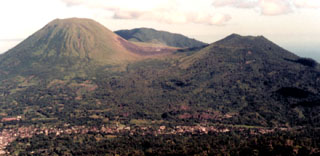Report on Lokon-Empung (Indonesia) — March 2006
Bulletin of the Global Volcanism Network, vol. 31, no. 3 (March 2006)
Managing Editor: Richard Wunderman.
Lokon-Empung (Indonesia) Steaming and seismically active during January-October 2005
Please cite this report as:
Global Volcanism Program, 2006. Report on Lokon-Empung (Indonesia) (Wunderman, R., ed.). Bulletin of the Global Volcanism Network, 31:3. Smithsonian Institution. https://doi.org/10.5479/si.GVP.BGVN200603-266100
Lokon-Empung
Indonesia
1.3644°N, 124.7992°E; summit elev. 1580 m
All times are local (unless otherwise noted)
The twin volcanoes of Lokon and Empung exhibited low levels of activity during 2005. Table 9 is a summary of reported gas emissions and number of volcanic earthquakes during 2005.
Table 9. Summary of activity at Lokon-Empung during 2005, indicating the height and composition of plumes observed and the numbers of earthquakes recorded. Data courtesy of CVGHM.
| Date | Deep volcanic (A-type) | Shallow volcanic (B-type) | Plume height | Plume color and composition |
| 18 Jan-24 Jan 2005 | 9 | 75 | -- | -- |
| 24 Jan-30 Jan 2005 | 3 | 88 | 35 m | white gas |
| 02 May 2005 | 3 | 44 | -- | -- |
| 09 May 2005 | 3 | 139 | 50 m | white gas |
| 26 Sep-02 Oct 2005 | 6 | 117 | 15 m | white gas |
| 03 Oct-09 Oct 2005 | 5 | 126 | 25 m | white gas |
Geological Summary. The Lokong-Empung volcanic complex, rising above the plain of Tondano in North Sulawesi, includes four peaks and an active crater. Lokon, the highest peak, has a flat craterless top. The morphologically younger Empung cone 2 km NE has a 400-m-wide, 150-m-deep crater that erupted last in the 18th century. A ridge extending 3 km WNW from Lokon includes the Tatawiran and Tetempangan peaks. All eruptions since 1829 have originated from Tompaluan, a 150 x 250 m crater in the saddle between Lokon and Empung. These eruptions have primarily produced small-to-moderate ash plumes that sometimes damaged croplands and houses, but lava-dome growth and pyroclastic flows have also occurred.
Information Contacts: Dali Ahmad, Hetty Triastuty, Nia Haerani and Suswati, Center of Volcanology and Geological Hazard Mitigation (CVGHM), Jalan Diponegoro 57, Bandung 40122, Indonesia (URL: http://www.vsi.esdm.go.id/).

